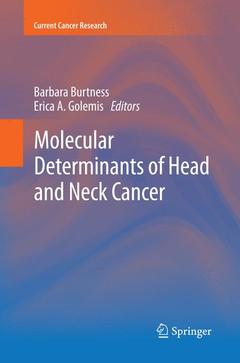Molecular Determinants of Head and Neck Cancer, Softcover reprint of the original 1st ed. 2014 Current Cancer Research Series
Coordonnateurs : Burtness Barbara, Golemis Erica A.

Barbara Burtness, M.D. is Associate Director for Clinical Research at the Fox Chase Cancer Center. She is also a co-leader of the Keystone Program in Head and Neck Cancer. As Chair of the Head and Neck Committee in the Eastern Cooperative Oncology Group and a member of the NCI Head and Neck Steering Committee, she helps shape the national agenda for research on all stages of head and neck cancer.
Erica Golemis, Ph.D. is the Deputy Chief Scientific Officer at the Fox Chase Cancer Center. She is also the Co-Leader of Developmental Therapeutics and Co-Leader of the Head and Neck Cancer Keystone at Fox Chase. Her research seeks to define the changes in cell signaling that occur as tumors spread by metastasis and develop resistance to drugs, with the ultimate goal of inhibiting these processes.
Ouvrage de 362 p.
15.5x23.5 cm
Thèmes de Molecular Determinants of Head and Neck Cancer :
Mots-clés :
Dna repair; Human Papillomavirus; genomics; head and neck cancer; hypoxia; molecular determinants



